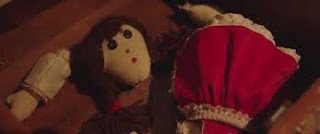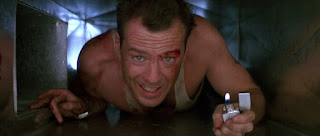The Iran/Iraq conflict forms the backdrop
for an exceptional chiller in Babak Anvari’s
Under the Shadow
(Review)
UK, Jordan, Qatar, 2016/ Cert. 15/ 84 mins
Director: Babak Anvari
Cast: Narges Rashidi, Avin, Manshadi,
Bobby Najeri, Ray Haratian, Aram Ghasemy
From the British independent film company
Wigwam Films comes the UK, Qatar and Jordan co-production Under the Shadow, written and directed by Babak Anvari. Set in
Tehran in 1988 during the Iran/Iraq war, Anvari’s debut feature was premiered
at the Sundance Film Festival in January and has been deservedly well received
by critics. The film succeeds on a generic level, providing genuine
jump-in-your seats moments demanded from a horror audience. It also succeeds in
utilising the horror genre to comment upon the nature of war and the status of
women in post-revolution Iran after the Ayatollah Khomeini came into power.
The film’s plot centres upon Shideh
(Narges Rashidi) and her young daughter Dorsa (Avin Manshadi) who are living in
a Tehran tenement building struggling to cope with the chaos of the conflict. Her
husband, Iraj (Bobby Naderi), is a doctor who has been enlisted to join the
military and has been assigned to the front and Shideh has opted to remain in
the city rather than stay with his parents in the country. At the beginning of
the film we discover that Shideh wishes to continue with her medical studies
but she is bluntly informed by the Director of the University (Bijan
Daneshmand) that as she was active in a left-wing organisation during the
revolution her application has been denied. Shideh becomes depressed by the decision
and the curtailment of her ambition to become a doctor and this leads to
tension in the marriage which is further exacerbated by her decision to remain
in Tehran. With her husband away, the shelling of the city intensifies and the
tenants of the block are forced to gather in the basement for safety until an
unexploded missile crashes into the building’s roof. Gradually the rest of the
occupants leave the tenement block until only Shideh and her daughter remain, with
Dorsa increasingly disturbed by visions and convinced that as the missile burst
through the roof it has let in a malevolent spirit- a Djinn in Islamic folklore-into
the building.
Under
the Shadow’s
Iranian setting immediately brings to mind Ana Lily Amirpour’s 2014 vampire film
A Girl Walks Home Alone at Night
although the two films are considerably different in tone and form as
Amirpour’s horror is heavily stylised and far more idiosyncratic than Anvari’s
more conventional chiller. A more valid comparison can be found with Jennifer
Kent’s psychological horror The Babadook
(2014) as both films deal with the isolation of a mother and child and deal
with horrors- either real or imagined- suggestive of mental anguish or
breakdown. Much of the film’s impact owes a great deal to its domestic setting
and how it manages- to paraphrase Alfred Hitchcock- to bring terror back into
the home. Its suspense is derived from the fact that we really care about the
characters and the reality of their situation as Under the Shadow, like The
Babadook, has a mother left alone to cope with a young, highly imaginative
and fearful child, concerned for her own sanity and child’s safety. When she is
informed that there is an evil presence in the tenement block by Mrs Ebrahimi,
an elderly and devout Muslim, who states that the djinni ‘travel on the wind,
they always know how to find you’, Shideh’s rationality leads her to dismiss
her neighbour’s warning. But when Dorsa’s favourite doll inexplicably
disappears and Shideh is told that the spirits steal a favourite item in order
to take possession of its owner, she can no longer ignore the possibility of
the paranormal. Shideh eventually comes around to believing her daughter’s
assertion that an evil spirit lurks in the building and, increasingly plagued
by her own nightmares and visions, agrees to leave for her husband’s parents as
soon as the doll is found.
In a similar manner to Kent’s film, the
spirit attempts to drive a wedge between mother and child. Both The Babadook and Under the Shadow locate their psychological dread in the real and there
is a theological struggle in both films between rationality and a belief in the
supernatural. The Babadook’s threat
emerges from the grief of the mother at the loss of her husband and the
repressed resentment this causes her to feel towards her son. Under the Shadow’s terror originates in
Shideh’s thwarted ambition to practise medicine, the devastation of the war and
the increasing repression imposed upon women living under the revolutionary
regime- the “shadow”- implied by the title.
Shideh has a modern feminist outlook on
life which contradicts the edicts of the Islamic regime. We see her exercising in
the living room to a Jane Fonda Workout
video and as video players are frowned upon as anti-Islamic she has to warn her
daughter not to mention the fact that they own a VCR to their neighbours. At
one point in the film Shideh and her daughter flee the tenement in terror and
they are picked up by the military police. In the haste to escape the entity
that dwells in their apartment, Shideh has forgotten to wear her veil in
public- a punishable offence for women under Sharia law- and they are forced to
spend the night in a police cell until Shideh is cautioned by an official the
next morning.
With Under
the Shadow, Anvari emerges as new directorial talent and his debut promises
much for the future. Rather than pound the audience with special effects, the
film shows admirable restraint with Chris Barnwell’s editing and Kit Fraser’s
cinematography complementing, rather than intruding upon, the narrative which
avoids explicit violence and gore for a more cerebral, psychologically disquieting
atmosphere. The point-of-view cuts during Shideh’s terrifying hallucinations
are effective, as are the rotated camera angles of her lying upon her bed which
demonstrate her apprehensive state of mind and skilfully signpost the beginning
of her waking nightmares. Similarly, Under
the Shadow promotes the edict that a little is enough in its portrayal of
the djinn which is, for the most part, fleetingly glimpsed and is much more sinister
for being so. Both intelligent and genuinely scary, Under the Shadow adroitly manages to unsettle, sending several
satisfactory chills down your spine whilst successfully weaving a socio-political
comment on Iran during the period into its horror narrative You will still be shaking
from its psychological terror and engaging with its nuanced subtexts long after
the credits roll.





.webp)

Comments
Post a Comment